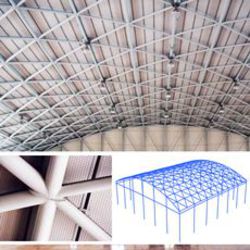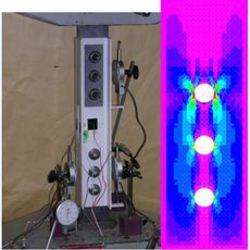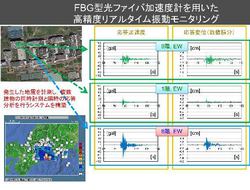
Matsumoto, Yukihiro
| Affiliation | Institute for Research on Next-generation Semiconductor and Sensing Science (IRES²) |
|---|---|
| Concurrent post | Research Center for Collaborative Area Risk Management (CARM) Department of Architecture and Civil Engineering |
| Title | Professor |
| Fields of Research | Structural Engineering |
| Degree | Dr. of Engineering |
| Academic Societies | Architectural Institute of Japan / Japan Society of Civil Engineers / Japanese Society of Steel Construction / Japan Society for Composite Materials /Japan Association for Earthquake Engineering / The Japan Society of Mechanical Engineers / International |
| y-matsum@ace Please append ".tut.ac.jp" to the end of the address above. |
|
| Laboratory website URL | http://sel.ace.tut.ac.jp/y-matsum |
| Researcher information URL(researchmap) | Researcher information |
Research
Seismic and Buckling Design Methodology of Shell & Spatial Structures
Structural Design of FRP Structures
Reinforcement and Strengthening for Steel Members using CFRP
Structural Health Monitoring using Fiber Bragg Grating Sensor
Theme1:Buckling and seismic response behavior of shell and spatial structures
Overview
For the design of shell-like space frames located in seismic area, it is very important to give considerable attention to the dynamic and buckling behavior. However, for single layer latticed cylindrical roof structures, it has not been enough to make clear their dynamic responses during earthquake and to estimate the load carrying capacities. Also, it is well-known that metal shells and shell-like lattice frame structures have buckling behaviour which is very sensitive to initial geometric imperfections. Our research interests are as follows.
1) buckling behavior of thin-walled cylinders
2) buckling behavior of latticed shell structures
3) seismic response behavior of shell and spatial structures
Selected publications and works
Nhut Phan Viet, Yukio Kitano, and Yukihiro Matsumoto: Experimental Investigations of Strengthening Effects of CFRP for Thin-walled Storage Tanks under Dynamic Loads, Applied Sciences,Volume 10, issue 7, 22 pages, 2020.4. [https://doi.org/10.3390/app10072521]
Nhut Viet PHAN, Yukihiro MATSUMOTO, Takahiro MATSUI, Hitoshi NAKAMURA: Strengthening effects of circumferential CFRP layers for thin-walled steel cylinders under axial compression, Japan Society of Steel Construction, Steel Construction Engineering ,No.26, Vol.103, pp.15-29, 2019.9.
Krishna Kumar Bhetwal, Seishi Yamada, Yukihiro Matsumoto and James G. A. Croll: Nonlinear Elastic Buckling of CFRP Reinforced Steel Cylinders under Axial Compression, Journal of Civil Engineering and Architecture,Volume 6, No. 8,pp.933-943,2012.8
Keywords
Theme2:Fundamental study on FRP material for building and civil structures
Overview
FRP material has good characteristics such as light-weight, high-strength and high-corrosion resistance. Light-weight structure possesses some advantages over the seismic load and rational constructing procedure. Our research interests are as follows.
1) Mechanical characteristics of bolted and adhesively bonded joint for FRP
2) Effects of reinforcement using CFRP
3) Design method of FRP structures
4) Long-term characteristics of FRP material
Selected publications and works
Fengky Satria Yoresta, Ryotaro Maruta, Genki Mieda, Yukihiro Matsumoto: Unbonded CFRP strengthening method for buckling control of steel members, Construction and Building Materials,Volume 241, 14 pages, 2020.4. [https://doi.org/10.1016/j.conbuildmat.2020.118050]
Genki Mieda, Hitoshi Nakamura, Takahiro Matsui, Yutaka Ochi, Yukihiro Matsumoto: Mechanical behavior of CFRP on steel surface molded and bonded by vacuum assisted resin transfer molding technology, SN Applied Sciences,Volume 1, Issue 6, 2019.5. [https://doi.org/10.1007/s42452-019-0603-4]
Keywords
Theme3:Structural health monitoring by using fiber Bragg grating sensor
Overview
Structural health monitoring (SHM) is developed in order to detect the degradation of the structural mechanical performance.
We have been performing the vibration monitoring by using the recently developed fibre Bragg grating (FBG) sensors. Our research interests are as follows.
1) SHM using FBG accelerometers for buildings
2) SHM using FBG sensors for steel bridges
3) SHM using FBG sensor for adhesively bonded layer
Selected publications and works
Michail Sidorov, Phan Viet Nhut, Yukihiro Matsumoto and Ren Ohmura : LoRa Based Precision Wireless Structural Health Monitoring System for Bolted Joints in a Smart City Environment, IEEE Access,Volume 7, pp.179235-179251, 2019.12. [https://doi.org/10.1109/ACCESS.2019.2958835]
Y. Mizuno, S. Hagiwara, H. Lee, Y. Ochi, T. Matsui, Y. Matsumoto, Y. Tanaka, H. Nakamura, and K. Nakamura: Infrared thermometry for breakage detection of optical fibers embedded in structures, Applied Physics Express (APEX), vol. 12, no. 6, 2019.5. [https://doi.org/10.7567/1882-0786/ab1e92]
Yukihiro MATSUMOTO, Akihiko YOSHIIWA, Takuya MATSUMOTO and Chiharu ORIKASA: Damage monitoring by using fiber Bragg grating sensors for adhesively bonded joints, SMAR 2015 Antalya Proceedings(ISBN 978-3-905594-65-2) (SMAR 2015) (Antalya, Turkey), 2015.9
Keywords
Title of class
Undergraduate program
(B1011004b)Linear Algebra 1
(B10110020)Engineering and Science Laboratory
(B1013009a)Physics Laboratory
(B15510170)Structural Mechanics 1
(B15510070)Structural Mechanics 2
(B15620110)Steel Structures
Graduate program for master's degree
(M25620040)Steel Structure Design




